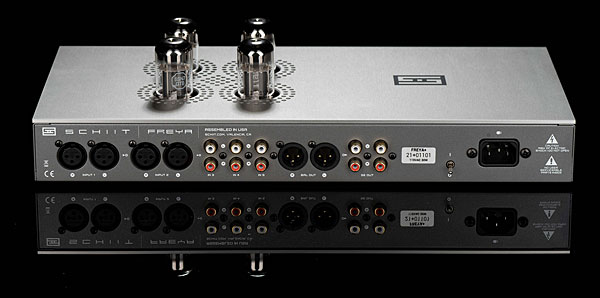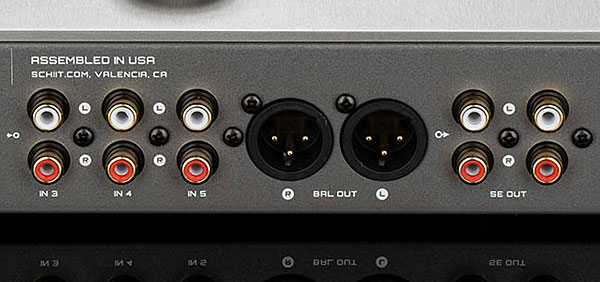| Columns Retired Columns & Blogs |
seems like a no brainer for a rich, musical, amp/pre-amp combo. Tubes + sort of Class A = something I want to try.

But why not? As I wrote in reviewing a tube preamp back in 1997, "if the results are worthwhile, why should I care if the designer builds an amp powered by rats on a treadmill?"
I included the Freya + when I began looking around for a simple, inexpensive, deadly clean preamp that met my basic requirements: balanced inputs and outputs, a relay-switched resistive-ladder volume control, and a remote control. The solid state Freya S ($599), which lacks a vacuum tube mode, also qualified, but I relished the opportunity to re-expose myself to vacuum tubes. The Freya + ticked all the boxes. It has two pairs of balanced XLR inputs, three pairs of unbalanced RCA inputs, one pair of XLR outputs, and two pairs of RCA outputs. In the active modes, the XLR output signals are balanced for all inputs. The latter is particularly useful because all the outputs are simultaneously active, and they allow the attachment of multiple amplifiers, line-level crossovers, and subwoofers without clumsy splitters. (In the completely passive mode, signals are passed from input to volume control and out; without active elements, there is no way to convert an unbalanced signal into a balanced signal output. Thus, only in this mode, RCA input signals appear unbalanced on the XLR outputs.)
Setup and ergonomics
The Freya + comes double boxed in plain brown corrugated cardboard, with sufficient foam insulation and support. A second, smaller box contains four matched new-production Tung-Sol 6SN7GTB tubes. At 11lb, the Freya + isn't a heavyweight, but considering its compact size, it's substantial. Most of the weight, apart from the chassis, takes the form of two transformers, a 48VA one for the tubes and a 24VA one for the rest of the circuitry and controls.

Setup was easy. I inserted the four tubes into the only places they can go, installed the battery in the remote control, and inserted the AC cord into the IEC socket on the back. My system uses balanced connections, so I connected a pair of XLR cables to Input 1 and another pair to Bal Out.
The labels on the front panel controls and LEDs are tiny, cryptic symbols—so small that they weren't very useful; until I committed them to memory, I needed the diagram in the booklet at my side. The volume knob is small with little sensory feedback—just the soft clicking of the relays that it operates. The only indication of the volume setting—apart from the volume of the music playing—is a small, uncolored depression on the knob. Even in a well-lit room, I was unable to see it from 2' away; in dimmer light suitable for relaxed listening, it was invisible. I could also carp about the remote control's strange and tiny labeling—and yet, that said, the Freya + controls were responsive and reliable.
All the controls and indicators are toward the right side of the front panel and centered under the tube quartet. On the extreme right is a "Status" LED that blinks when it is starting up and when tube mode is turned on or off—that is, it blinks when the preamp is powered up but not yet passing a signal and is off for normal operation. A line of five LEDs indicates the selected input, and a touch button selects one of the five inputs sequentially. Then comes the volume knob and, to its left, a button that selects the output mode. Activation of the passive and solid state modes is instantaneous; there is a delay of about 45 seconds when tube mode is activated, unless the tubes are already warmed up. The Freya's power switch is on the back of the chassis, implying that Schiit intends for the Freya to remain on most of the time. If you do leave it on, it's best to switch it into SS or passive mode to preserve tube life; in either of these two modes, the Freya + removes power from the tubes and associated circuitry.

Listen × 3
The Freya +'s three distinct circuit configurations argue for its consideration as three distinct preamplifiers. I started listening with the Freya + in passive mode; as one might predict, the sound was clean and uncolored. I had recently downloaded some free tracks by Carmen Gomes from Sound Liaison to fritter away some time comparing formats. Regardless of format, the sounds were transparent, balanced, and startlingly spacious—the same as when I physically bypassed the preamp by connecting the input cables directly to the output cables. The Freya was dead quiet at all level settings. If passive mode was the only way to run the Freya +, it would be useful as an input selector and volume control that could be inserted into any system without audible penalty.
However, experience tells me not to presume that the passive mode is perfect in all applications. I run 10m balanced interconnects to the power amps, and the insertion of a competent active line driver has, in the past, improved the sound compared to running direct from volume-controlled DACs. Unable to contain my curiosity, I touched the button to put the Freya + into solid state differential buffer mode. On "A Fool for You" (24/352.8 FLAC), the bass was even better defined, though it was neither more nor less pronounced than in passive mode.
The midrange seemed a trifle restrained, or relaxed, depending on the context. For example, Gomes's voice was firmly anchored to my center loudspeaker in passive mode but, while still centrally placed, it was a step back and better integrated into the soundstage in buffer mode. Treble detail seemed just a bit increased. Noise at all levels was inaudible.
With larger ensembles, I noticed the same differences, and more. The opening track ("Lunge da voi, ben mio") on a collection of Kapsberger's music performed by L'Escadron Volant de la Reine (CD, Il Tedesco a Roma, Harmonia Mundi HMM902645), the solo voices were pure and intimate in both modes, but the SS buffer mode filled out the space around them more completely. When the whole ensemble joined in, the differences between the two modes were magnified.

seems like a no brainer for a rich, musical, amp/pre-amp combo. Tubes + sort of Class A = something I want to try.

I've owned many Schiit pieces, even their very first design.
Stereophile's reviewers personally introduced me to the Schiit people at RMAF 2011, I've owned Schiit gear ever since !
Schiit gear seems consistently outstanding in two ways: 1.) Sound Quality and 2.) Value for Money !!
The Schiit gear is reliable and retains an amazing 80% of it's MSRP on the used market. ( eBay )
The Schiit Valhalla 2, with Russian Tubes , continues to be one of finest sounding Pre-Amps I've ever discovered, phew!!!!!
But, Schiit continues to insist on retaining two easily corrected problems :
1.) The control labelling seems indeciferable
2.) The Power Switch is on the back
It seems puzzling that Schiit's designers created such a wonderful Company, built products that are so widely loved and even cherished yet insist on making us cope with such easy to remedy problems.
I properly label my gear so that it's easily readable in the dark and even build an outboard power switch so that I don't have to reach around the back.
Schiit is an Outstanding Company, they build far better quality then they charge for, they consistently deliver sound quality, don't have reliability issues and their stuff re-sells Globally..
I wish it didn't have a Shity name.
Tony in Florida

" by tonykaz: It seems puzzling that Schiit's designers created such a wonderful Company, built products that are so widely loved and even cherished yet insist on making us cope with such easy to remedy problems."
by JA: "My only caution is that the high output impedance at low frequencies from all the outputs will result in a lightweight balance with power amplifiers that have an input impedance much below 10k ohms."
Probably easy fix with a larger coupling output cap, and many of today's amps are some at 2kohm input impedance (no bass then from this pre into them)
Cheers George

Russian Glass Tubes are NOW Sanctioned ! OUCH
I wonder if this politically correct site will take this report down ? , Stoddard worries that the moderated Head-Fi will take-down his Russian Tube problem report.
This political censoring is nonsense
Tony in Florida

Russian Glass Tubes are NOW Sanctioned ! OUCH
I wonder if this politically correct site will take this report down?
First, the Freya+ (and its Russian tubes) were assembled and reviewed long before the invasion of Ukraine.
Second, the Freya+ permits us to express our position by actively bypassing the Russian tubes on a daily basis. (I don't know how the Freya+ will function if you pulled them.)
I pronounce it like SKITE if anyone asks lol.
I choose not to pronounce it at all.

for us to endure .
Tony in Florida


related to Fertiliser manufacture originate in Mother Russia, those imports are also sanctioned.
Of course, we can always eat Cake - can't we ?
Tony in Florida

Just wait for it. I probably purchased my last high dollar vinyl for now. A $60 MOFI release of ELO Eldorado. I suspect companies like Schiit will do well with their low price offerings, as consumers navigate the minefields of high inflation, shortages, and whatever else is coming next.

I'm hearing that the supply of PVC for the vinyl record injection moulding is doubtful for future months.
This stuff is very much imported and dependant on Oil imported from Sanctioned sources.
We are all intended to feel the pain, it is said.
Tony in Florida

I would love to see a review of the Saga S. I have one, and have a similar impression to KR as far as the buffer stage sound. For $299, it is an extremely clean sounding preamp with excellent build quality. I, like Tony, just wish they didn't have that name. I pronounce it like SKITE if anyone asks lol.

and delighted to see it get class A in Stereophile. I own one and love it with some upgraded tubes. I think the tubes took it to a whole other level in my system. I really like the tube circuit it just fleshes out the bottom in my system and adds a little warms, it's just right. I was thinking of trying a really expensive tube preamp to compare but I might not even bother. Between this an the Decware Zen triode amp any regular Joe can experience sound that is near as good as it gets and get a no BS product where you get real value for you dollar.